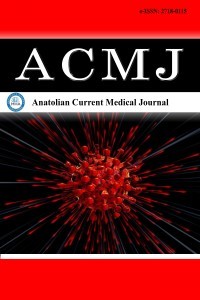1.
Yalçın Gürsoy M, Mechmet FC. Nursing students' attitudes toward reporting child abuse and neglect: a cross-sectional study in Turkey. J Child Adolesc Psychiatr Nurs. 2023;36(3):220-227. doi:10.1111/jcap.12416
2.
Cevik Durmaz Y, Tuncer Coban P, Eseroglu Soylemez T, Aktas H. Effectiveness of the training provided to healthcare professionals in Turkey to recognise the symptoms and risks of child abuse and neglect. Health Soc Care Community. 2022;30(5):e1898-e1906. doi:10.1111/hsc. 13620
3.
Güvenlik birimine gelen veya getirilen çocuk istatistikleri (2024).
4.
Alaggia R, Collin-Vézina D, Lateef R. Facilitators and barriers to child sexual abuse (CSA) disclosures: a research update (2000-2016). Trauma Violence Abuse. 2019;20(2):260-283. doi:10.1111/hsc.13620
5.
Pereda N, Guilera G, Forns M, Gómez-Benito J. The prevalence of child sexual abuse in community and student samples: a meta-analysis. Clin Psychol Rev. 2009;29(4):328-338. doi:10.1016/j.cpr.2009.02.007
6.
Lines L, Grant J, Hutton A. How do nurses keep children safe from abuse and neglect, and does it make a difference? A scoping review. J Pediatr Nurs. 2018;43:e75-e84. doi:10.1016/j.pedn.2018.07.010
7.
Lines LE, Hutton A, Grant JM. Navigating and negotiating meanings of child abuse and neglect: Sociocultural contexts shaping Australian nurses’ perceptions. Health Soc Care Community. 2020;28(3):941-949. doi:10.1111/hsc.12925
8.
Thomas R, Reeves M. Mandatory reporting laws. StatPearls Publishing; 2023.
9.
Alfandari R, Enosh G, Nouman H, Dolev L, Dascal-Weichhendler H. Judgements of physicians, nurses, and social workers regarding suspected Child maltreatment in community health care services. Health Soc Care Community. 2022;30(6):e4782-e4792. doi:10.1111/hsc. 13885
10.
Uysal A, Erefe İ. Çocuk istismarı ve ihmalinin belirti ve risklerini tanılamada hemşire ve ebelerin bilgi düzeylerinin saptanması. Unpublished master’s thesis, Ege Üniversitesi, İzmir, 1998.
11.
Turan T, Erdoğan Ç. Sağlık çalışanlarının çocuk istismarını/ihmalini raporlamaya karşı tutumlarını belirleme ölçeği’nin öğrenci hemşirelerde geçerlik ve güvenilirliği. JAREN. 2019;5(1):46-52.
12.
Metinyurt HAI, Sarı HY. Sağlık çalışanlarının çocuk ihmali ve istismarını tanıma düzeyleri. Çocuk ve Medeniyet. 2016;1(1):101-121.
13.
Üstündağ A. Sağlık çalışanlarının çocuk istismarı ve ihmali konusundaki farkındalığı: Sağlıklı hayat merkezi örneği. Sürekli Tıp Eğitimi Dergisi. 2022;31(4):241-253. doi:10.17942/sted.1033071
14.
Mathews B, Kenny MC. Mandatory reporting legislation in the United States, Canada, and Australia: a cross-jurisdictional review of key features, differences, and issues. Child Maltreat. 2008;13(1):50-63. doi: 10.1177/1077559507310613
15.
Ceccucci J. Evaluating nurse practitioners perceived knowledge, competence, and comfort level in caring for the sexually abused child. J Forensic Nurs. 2018;14(1):42-49. doi:10.1097/JFN.0000000000000184
16.
Eslek D, Irmak TY. Çocuk cinsel istismarını önlemede “dersimiz: güvenli ilişkiler” programının etkililiğinin değerlendirilmesi. Türk Psikoloji Derg. 2022;89:1-78. doi:10.31828/tpd1300443320200824m000039
17.
Evgin D, Sümen A. Childhood abuse, neglect, codependency, and affecting factors in nursing and child development students. Perspect Psychiatr Care. 2022;58(4):1357-1371. doi:10.1111/ppc.12938
18.
Söyünmez S, Zülkar Y, Turan FD, İşler Dalgıç A. Awareness about abuse of parents who have children with epilepsy. Epilepsi. 2021;27(2):102-112. doi:10.14744/epilepsi.2020.50023
19.
Hendaus MA, Al-Khuzaei AM, Samarah O, Hamad SG, Selim BA, El Ansari W. Child abuse and neglect in a rapidly developing country: parents’ perspectives. J Family Med Prim Care. 2020;9(6):3053-3059. doi:10.4103/jfmpc.jfmpc_971_19
20.
Shah SM, Nowshad G, Dhaheri FA, et al. Child maltreatment and neglect in the United Arab Emirates and relationship with low self-esteem and symptoms of depression. Int Rev Psychiatry. 2021;33(3):326-336. doi:10.1080/09540261.2021.1895086
21.
Al-Mahroos FT, Alnoaimi AA, AlAmer EA, et al. Child maltreatment prevention readiness in Bahrain. Int J Pediatr Adolesc Med. 2021;8(3):149-153. doi:10.1016/j.ijpam.2020.03.010
22.
Tiyyagura GK, Gawel M, Alphonso A, Koziel J, Bilodeau K, Bechtel K. Barriers and facilitators to recognition and reporting of child abuse by prehospital providers. Prehosp Emerg Care. 2017;21(1):46-53. doi:10.1080/ 10903127.2016.1204038
23.
Stevens SL, Alexander JL. The impact of training and experience on EMS providers' feelings toward pediatric emergencies in a rural state. Pediatr Emerg Care. 2005;21(1):12-17. doi:10.1097/01.pec.0000150982.96357.ca
24.
Glaeser PW, Linzer J, Tunik MG, Henderson DP, Ball J. Survey of nationally registered emergency medical services providers: pediatric education. Ann Emerg Med. 2000;36(1):33-38. doi:10.1067/mem.2000. 107662
25.
Markenson D, Tunik M, Cooper A, et al. A national assessment of knowledge, attitudes, and confidence of prehospital providers in the assessment and management of child maltreatment. Pediatrics. 2007; 119(1):e103-e108. doi:10.1542/peds.2005-2121
26.
Lazenbatt A, Freeman R. Recognizing and reporting child physical abuse: a survey of primary healthcare professionals. J Adv Nurs. 2006; 56(3):227-236. doi:10.1111/j.1365-2648.2006.04030.x
27.
Egry EY, Apostolico MR, Morais TCP. Reporting child violence, health care flows and work process of primary health care professionals. Cien Saude Colet. 2018;23:83-92. doi:10.1590/1413-81232018231.22062017
28.
Foster RH, Olson-Dorff D, Reiland HM, Budzak-Garza A. Commitment, confidence, and concerns: assessing health care professionals’ child maltreatment reporting attitudes. Child Abuse Negl. 2017;67:54-63. doi: 10.1016/j.chiabu.2017.01.024

